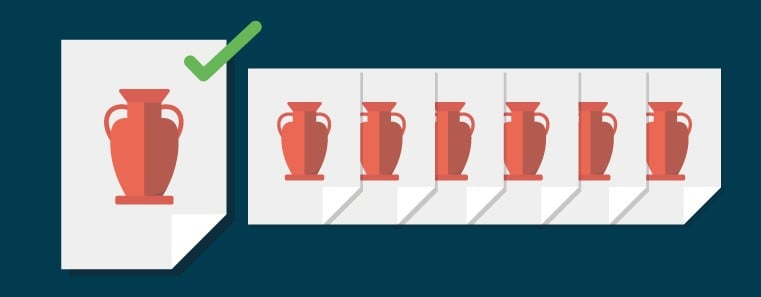
ECommerce SEO can be horrendously confusing and time consuming so to make things easier we’ve compiled a comprehensive checklist to make managing your site’s SEO much simpler.
Getting the foundations of your website right is essential to long term search visibility gains – by covering everything on this eCommerce SEO checklist you’ll give yourself the biggest opportunity to maximise visibility over time.
URLs
- Domain name – make sure your brand name is in the domain name (but if it’s too late, don’t bother changing it now).
- Avoid complicated URLs – keep things simple and clean, just use the product name in product URLs and avoid using adding detail. Rather than ‘/pink-fluffy-ribbon-2x1x200-with-brown-spots-stitch-detail’ use ‘pink-fluffy-ribbon’ instead.
- Dash spacers – check the words in your URLs are separated by a dash and not underscore or a space. You can find out more about simple URLs here from Google.
- Consistency in URLs – make sure your URLs are consistent across all products, category pages, information pages and every other piece of content within your site. It makes life much easier for search engines and users trying to find your products.
- Independent product URLs – If you have multiple products in multiple categories, make sure your product URLs are not dependent on a category URL. So, rather than ‘/category-one/product-a/’ and ‘/category-two/product-a/’ make your product URLs independent, removing the category level altogether so you end up with a clean product URL. This would look like ‘/product-a/’ and will help prevent content duplication.
- Single URL per product – many eCommerce websites use a URL structure that provides unique URLs for every single variation of the same product. Most of the time this is colour. We recommend using filters as opposed to individual URLs for this, for example ‘/product-a?colour=blue’ rather than ‘/product-a-blue’.
Canonicalisation
- Canonicalise products – Canonicalising is the process of marking known duplicate content and saying: “Hey search engines! This URL is the ‘primary’ version of these pages!” There’s a good explanation here and Google has written about them too, but if your eCommerce site uses separate URLs for colours or other product options and filters, they need canonicalising to their primary version. If using filters, for example ‘/product-a?colour=blue’ then canonicalise the page back to the ‘clean’ version: ‘/product-a’.

- Canonicalise category pages – The same applies to your category pages. Your category pages most likely use filters too, so apply a canonical tag to these. For example, if you had ‘/category-a?display=grid’, the canonical URL would be ‘/category-a’.
- Pagination canonicalisation – This can be where confusion starts. If you have pages for categories, make sure you use “rel=next/prev”. This is a way of canonicalising pages of products that tells search engines to show the first page of the pagination. However, you’ll also want to take into consideration the use of a ‘view all’ page if you have one, as this is often preferred by users. If that’s the case, we recommend canonicalising to this.
Meta Data
- Uniqueness – Make sure all your title tags and meta descriptions are unique. Google will flag those that are duplicated in your Google Search Console.
- Title tag length – Keep these under 55 characters to make sure they get properly displayed.
- Meta description length – These should be below 155 characters to make sure they don’t get truncated. This way your whole message will get displayed and not cut short.
- Product USPs – What are the odds that hundreds of other online retailers are selling the same product you are? How do you make a product unique that’s widely available? You, your service, your brand, your price, your delivery, your delivery threshold (to name a few) do. Make sure these are in the title tags where people can immediately see why they should buy that product from you. Use the meta description to further explain not only the product, but why they should come to you for it.
- Keywords – Make sure you include keywords but don’t go stuffing them in left, right and centre as this will only be detrimental to your search visibility efforts.
Imagery
- More than one product image – Each product should have more than one image. So many eCommerce sites are simply lazy with their product images. Make your own; it’s worth the effort of finding another way to be different and unique from the competition. Everyone uses the same manufacturer- or brand-provided imagery, so make your own. The more images you use of a product, the more likely someone will buy it. eBay states that more images on seller pages increase sales.

- ALT text – Check that each and every one of your images has logical, descriptive ALT text on them. ALT text isn’t seen by a reader but acts as a descriptor if, for whatever reason, images can’t be displayed. They’re a good opportunity to include a keyword mention too.
- Image filename and size – Check that your images aren’t massive, they should certainly be under 500kb. Image load times are one of the top three reasons for slow page load times, which impacts your rankings and visibility. Finally, remember to change the filename from the default your camera gave it to something descriptive. This opens up the doors to lots of visibility through image search.
Internal Links
- Links to products – Linking from other content on the website to relevant product pages helps the internal structure of your site, makes it easier for search engines to find your products, whilst also guiding users through the process of finding and buying. Check, where appropriate, that you’re making things as easy as possible for people by linking internally from relevant phrases and pages to your products.
- Link from products – As well as linking to product pages, make sure you have useful links coming from them too. Perhaps you have some relevant blogs on using the product, or perhaps there’s an external review by a popular influencer? All these things help you sell the product but also make the page more authoritative. You can even link out to other sites, provided they’re reliable and contextually relevant.

Schema and structured data
Schema (or structured data as it’s also known) is a set of instructions in code format that sits on your website and provides additional information to search engines and, in turn, your users. By adding this information to your website you can increase click-through rate and possibly your visibility.
This is definitely worth getting your web team to implement. For eCommerce SEO, we recommend to:
- Specify your logo to display in search results.
- Show searchers how to contact you.
- Show potential buyers that you’re engaged on social media.
- Get your very own site search box within Google’s search result pages to help potential buyers find products faster.
- Make sure your brand name is being used in mobile search to help increase brand visibility.
- Check that your site’s breadcrumbs are being picked up by search and displayed again for easier user navigation.
- Make sure your hard-made product videos can easily be found and displayed.
- Get your products more visibility in search with product mark-up. This can help increase traffic directly to the product pages and increase sales.
- Make sure your prospects are seeing what great things current customers and buyers are saying about your business and products with review snippets.
Responsive website
A responsive website is one that adapts to whatever device your potential customers are using. This is important, as you could be losing sales through mobile if you don’t also provide these users with a great buying experience.
- Check your website’s responsiveness – You can check to see if your website is appropriately responsive with a tool from Google. If you find it’s not, we recommend discussing with your web team about making the change.

Broken links
- Check for broken links – There are lots of free tools that can do this (including through your Google Search Console, which we recommend as being the first place to direct your web team). Broken links are bad for search engine crawling of your site and for user experience, so you need to make sure your eCommerce website has as few as possible.
- Amend broken links – Once you’ve found these links you need to fix them. There are many ways to do this but we recommend having your web team look at the source of the broken link and fixing it from there.
Page load speed
- Check page load times – How quickly your pages load impacts your visibility in search. There are lots of studies performed on this and you need to make sure your eCommerce website loads as quickly as possible.
- Use tools that are available to do this; Google also provides a tool to check page speed. Action the recommendations from these tools and continue to monitor it for further improvements.
Name, Address and Phone Number
- On every page – Make sure your name, address and phone number (NAP) are included on every page of the site. It’s very important to make sure these details are accurate wherever your brand is mentioned, including across your site. Google goes looking for this information and uses it as a ‘flag’, matching up brand information wherever it’s found. This is good for you and your business.
Page Experience
- A new ranking signal (2021) that combines a number of existing signals into a single ranking factor – an important one, too.
- Loading times are a key component and Google now measures response times using Largest Contentful Paint (LCP), based on how long it takes for the main content of a page to load.
- Interactivity measures the time it takes for interactive elements to trigger after a user input, measured in milliseconds.
- Visual stability refers to visible page elements remaining in their original position after a page has fully loaded.
- Mobile-friendliness is another signal used for measuring page experience.
- Safe browsing measures protect your visitors from deceptive sites, malicious software, harmful downloads and other safety issues.
- HTTPS secure encryption is also listed as a signal for page experience.
- Intrusive interstitials is the final signal considered for page experience and you should pay special attention to mobile pages/sessions.
Content checklist
As well as the technical side of things, it’s important to remember the content you’re putting into your eCommerce platform too. The below provides a comprehensive checklist of things you need to look into or ask your web team to consider, to make sure everything is working.
E-A-T & YMYL
- Make sure every page is optimised for E-A-T.
- Understand that eCommerce websites are considered YMYL (your money or your life) pages and Google quality raters are especially strict about E-A-T principles.
- Ensure every product description is accurate.
- Ensure every price is accurate.
- Avoid any additional or hidden fees.
- Clearly state any delivery fees.
- Have clearly defined return policies, product guarantees, T&Cs.
- Have full company info, contact details and FAQs.
Keyword usage
- Keyword overuse – Don’t go to town on stuffing in those keywords. Check that you’re not repeating yourself and read aloud blocks of text. Do they sound unnatural? Are there particular words that are being duplicated that make what you’re reading sound unnatural or manipulated?

- Keyword placement – Remember to check that keywords and phrases are included in the important places. These are: page title tag, page meta description, page copy, image ALT text and heading tag.
Product Pages
- Unique not manufacturer – Never use the manufacturer’s description of a product. You’ll be joining the band known as ‘the majority’ if you do so. Be unique and reflect your brand’s culture in the way you speak online to personalise the buying experience.
- As much information as possible – Don’t just include the basics; provide as much information as you can on the product. Think about what the customer cares about and what they’ll really want to know beyond on the obvious. Look at your competitors’ product content and ask yourself “what questions do I have that they don’t answer?”
- Include USPs – As well as your product having USPs, you as an online retailer also have USPs – remember to include and emphasise these. You should be answering the question: “Why should I buy this product from you and not your competitor?” Don’t just rely on price, there are many other reasons buyers will purchase from an online store.
- Focus on delivery – Delivery is one of the most important aspects of the online shopping experience and there’s clear evidence that competition on getting products to consumers quickly is getting hotter and hotter. Do you offer free delivery? Next-day fulfilment? What else makes your delivery service special or unique?
- Content – Don’t do what everyone else does. Include more imagery, more perspectives of the product, create your own imagery, make videos, demo the products and anything else you can think of to make what you offer stand out from everyone else.
- Upsell – Upselling your products can also be a great revenue generator. It’s not news that upselling can be 20 times more effective than cross-selling online. Make sure you’re integrating this into your product page offering.
- Cross-sell – Have you included cross-sell opportunities? What products may go well with others? Amazon reports that up to 35% of its revenue comes from cross-selling products.

- Social signals – Make sure that users and customers can share your product pages. Provide a way for them to spread the word through their own channels by including social widgets on the product pages.
- Product reviews – Don’t forget to check you can receive reviews on the product pages. Display them and mark them up with review structured data. This will help click throughs, increase purchases and get you more visibility.
Category Pages
- Have copy – Don’t leave your category pages hanging without copy; it provides context and information not only to search engines but users too. It offers somewhere to reinforce your USPs, tell the user what you have on offer and many other useful factors.
- Symbols – Use symbols to improve the user experience. Are there products with free delivery? Perhaps there are products with discounts available or special offers? Make sure you make these obvious to the user.
- Filtering options – Ensure you have a strong, user-friendly filtering capability. There are SEO obligations to filtering, though having them available in the first place is a requirement. There are various ways to filter your products within a category page, depending on your CMS or shopping platform.
Take a look at our eCommerce SEO tactics guide on category pages
Information Pages
Products and categories aren’t the only pages on your eCommerce website. The other information-based pages such as Terms and conditions, About us, Delivery information and many more, which are standard, are often forgotten. However, they still form a part of your website’s content and therefore shouldn’t be missed.
- Unique content – Make sure your information pages are also unique. Copying and pasting standard terms and conditions from another website may seem like a good idea, but it’s easy to accidentally copy across inaccurate information. Plus, although it may seem like an insignificant page compared to the money-makers, these pages can still be the source of duplicate content.
- Basic on-page optimisation – Make sure these pages aren’t missed in terms of basic on-page eCommerce SEO practices. The title tags and meta descriptions must be unique, pages should use heading tags and content must be well-formatted throughout.
- Law and legalities – Make sure you’re up to scratch on the law. Check your website clearly displays an address and contact details, maintains correct legalities on returns and refunds, distance selling regulations, data protection and, of course, the EU laws.
Out-of-stock / Discontinued Product Pages
- Return a 404 for pages that are permanently deleted.
- Return a 200 for pages that are temporarily unavailable.
- Return a 301 if you want to direct users to a relevant page.
- Alternatively, keep the page live and suggest similar products (recommended).
- Clearly label the page as out-of-stock or discontinued.
- Disable buy buttons and other interactive elements for out-of-stock or discontinued pages.
- Add a carousel to suggest recommended products with images.
- Make sure your product recommendations are relevant.
- Remove these pages from your site’s internal search and category pages so they don’t appear in regular sessions.
Off page optimisation checklist[1]
Reviews
- Encourage customers to leave reviews about your business and individual product purchases.
- Show product reviews on each product page.
- Use review schema to get review scores showing in Google Search.

- Use third-party review platforms like Trustpilot that partner with Google to maximise your scores.
- Make sure your services and products are worthy of high review scores.
- Deal with customer issues promptly and demonstrate the high standard of service on public platforms like Google Reviews, Trustpilot and social media.
- Respond to every review.
- Listen to feedback and take action if the same issue keeps arising.
- Make interactions conversational and human – don’t use scripted responses or bots.
- Never pay for reviews or bribe customers for leaving feedback.
Promotion
- Check local listings – Research what your local council offers in terms of online business listings. Check good quality local business directories and make sure your name, address and telephone number are all equal, matching across every mention of your brand and location.
- Claim Google+ listing – Claim your Google+ listing if you haven’t already. Make sure you complete the profile to 100 per cent; add a strong, unique and long description; make sure you use three accurate categories; and verify your location with the PIN request. Having a Google+ business listing is a great foundation for building your local visibility and providing Google with a trustworthy source of business information.

- Email subscription – Check that you have a way for potential customers to stay in the loop on what you have to offer by using email subscriptions to send a regular newsletter or email. This will gradually build up a database of contacts to receive offers, updates and new products.
- Create a blog – Having a blog where you can interact with potential customers, build a rapport with them and share news is an excellent way to promote your online store. Regularly updating it with useful, practical information that educates and entertains will gain you a loyal following over time.
- Paid advertising – From pushing products through to sales and brand awareness, paid advertising can really help promote your eCommerce store and get your business some good traction. This is especially true for new businesses or those expanding into new markets.
- Use social media – Promote your news, blog articles, offers, discounts and new products through the various social media channels. This provides another touch point and avenue from which to gain visibility, build authority and generate revenue. Engaging with people on social media also shows you’re active and not stagnant, in turn generating good trust signals which will help your sales and long-term visibility in search engines.
Talk to us about your eCommerce SEO
If you’d like help ensuring that your products are achieving maximum visibility in the SERPs, check out our eCommerce SEO services, call our eCommerce SEO team on 02392 830281 or drop us your details and we’ll get in touch.
 Call us
Call us 

